Abstract
Landslides are serious and complex geological and natural disasters that threaten the safety of people’s health and wealth worldwide. To face this challenge, a landslide displacement prediction model based on time series analysis and modified long short-term memory (LSTM) model is proposed in this paper. Considering that data from different time periods have different time values, the weighted moving average (WMA) method is adopted to decompose the cumulative landslide displacement into the displacement trend and periodic displacement. To predict the displacement trend, we combined the displacement trend of landslides in the early stage with an LSTM model. Considering the repeatability and periodicity of rainfall and reservoir water level in every cycle, a long short-term memory fully connected (LSTM-FC) model was constructed by adding a fully connected layer to the traditional LSTM model to predict periodic displacement. The two predicted displacements were added to obtain the final landslide predicted displacement. In this paper, under the same conditions, we used a polynomial function algorithm to compare and predict the displacement trend with the LSTM model and used the LSTM-FC model to compare and predict the displacement trend with eight other commonly used algorithms. Two prediction results indicate that the modified prediction model is able to effectively predict landslide displacement.
1. Introduction
Landslides are complex and common geological natural disasters [1] that cause harm or damage to humans and their living environment [2]. Landslides in China have become one of the most serious geological disasters due to their high frequency, wide range of influence and long duration. Geological disasters due to landslides not only threaten the safety of people’s health and wealth but also have a great impact on the economy, society and natural environment. Development of countries is greatly hampered by disasters such as landslides [3]. In China, the Three Gorges Reservoir area has many geological problems, especially landslides, due to its complex and diverse geological environment, different landforms and new tectonic movement, such as water storage. These problems have brought many property losses and casualties to the reservoir area and even affected the overall implementation of an irrigation project. According to China’s 2020 national geological disaster report, a total of 7840 geological disasters occurred in China in 2020, including 4810 landslides, accounting for the majority of geological disasters in China at 61.3 percent of the total. Additionally, landslide is increasing year by year due to more intense and frequent rainfall as a consequence of climate change [4]. Therefore, it is urgent to strengthen the monitoring and prediction of landslide displacement to reduce landslide hazards [5]. However, due to the complexity of landslide formation mechanism and inducing factors, landslide displacement prediction is still a difficult task. The study of landslide displacement is an effective means to solve landslide problems and better understand landslide movement [6].
Landslides can be regarded as nonlinear dynamic systems [7,8,9,10,11]. They can occur for a variety of reasons, such as morphology, geology and human activities [12,13,14,15,16]. Reasonable prediction of landslide displacement is still one of the key points in disaster research [17]. Recently, there have been many studies on landslide displacement prediction, although scholars have not fully understood its principle. Existing landslide displacement prediction models can be divided into two types: one is based on physical mechanism models, and the other is based on data-driven models. In the realm of data-driven models, machine learning (ML) methods have been diffusely used in landslide displacement prediction and have obtained good results and performance. In recent years, landslide displacement data have been decomposed into subsequences of different frequencies, and then all subsequences are combined to get a final predicted landslide displacement [18,19,20,21,22,23]. Lian et al. [18] used ensemble empirical mode decomposition (EEMD) method to decompose landslide displacement. they trained neural network with particle swarm optimization and gravitational search algorithm (PSOGSA) group algorithm, and proposed a CWC method as the loss function of PSOGSA algorithm, which achieved good prediction effect. Du et al. [19] also used EEMD method to decompose landslide displacement, and considered rainfall, reservoir water level and previous landslide displacement as three inputs of the training model. Grey Relational Degree (GRD) was used to calculate the correlation between the inputs and landslide displacement, and finally the PSO-ELM model was used to predict. Based on the time series analysis theory of global navigation satellite system (GNSS), The complete ensemble empirical mode decomposition with adaptive noise (CEEMDAN) method was used to obtain multiple sub-sequences of landslide displacement. Then, attention mechanism with long short time memory neural network (AMLSTM NN) was used to realize the joint prediction of multiple influencing factors [20]. In order to improve the accuracy of prediction, Zhou et al. [21] used 7 inputs and combined wavelet transform, PSO and ELM method to construct a prediction model with excellent prediction performance. Liu et al. [22] believed that rainfall, dam reservoir water level and landslide state were the key factors affecting landslide displacement. LSTM, RF and GRU models were used to predict landslide displacement, and Gini coefficient was used to quantify the prediction ability of the model. In research [23], researchers split landslide displacement by using variational mode decomposition (VMD) method, then they obtained several signals which are different frequencies. Each signal was separately predicted by stack LSTM model. The final displacement result was acquired by adding the results.
Wu et al. [24] provided a new idea and used a new gray prediction model to predict landslide displacement. Because RNNs are more appropriate for presenting nonlinear dynamic systems than FNNs, they have been used to predict landslide displacement [13]. A swarm intelligence algorithm combined with a machine learning algorithm uses the advantages of the swarm intelligence algorithm to improve the accuracy of the machine learning algorithm for landslide displacement prediction [21,25,26,27,28]. Guo et al. [25] utilized the advantage of grey wolf optimizer (GWO) method to optimize the back-propagation neural network (BPNN) and achieve the goal of accurately predicting landslide displacement. Ham et al. [26] proposed a hybrid machine learning displacement prediction model based on support vector machines, which accurately predicted the displacement of Majiagou landslide by taking into account the hysteresis of groundwater level changes. Deng et al. [27] constructed the last absolute shrinkage and selection operator—extreme learning machine (LASSO-ELM) model based on rainfall and acoustic emission and used 4 evaluation indexes, which achieved nice performance. Wang et al. [28] utilized the dynamic memory function of Elman neural network and combined it with genetic algorithm to effectively improve the prediction performance of neural network prediction model. The model provided an example for landslide displacement and deformation warning.
To better analyze landslide displacement, landslide displacement was divided into trend terms and periodic terms, and a polynomial model was used to predict the displacement trend of landslides, which achieved good performance [29,30,31,32,33,34]. In [35], researchers combined Verhulst inverse function with stochastic forest algorithm and obtained a landslide displacement prediction model combining empirical method and numerical method. Xie et al. [36] considered slope, rock mechanical properties, land use methods and other aspects, and they used an LSTM model directly to predict landslide displacement. In addition, many researchers regard the periodic displacement of landslides as time series data that are predicted by the original LSTM model, and good results are achieved [32,36]. Because there are many factors affecting landslide displacement, correlation degree methods were used to select the data variables of the model and consider which environmental factors are key and effective influencing factors, thus effectively improving the prediction accuracy of the model [19,32,37,38]. For the complex situation of landslide displacement prediction, some neural network models are improved and combined with the LUBE model. The new model does not predict landslide displacement points but rather generates interval predictions [9,18,39].
However, previous research achievements regarded landslide displacement or periodic displacement, rather than the trend of landslide displacement, as typical time series data. They did not consider that the value and meaning of the time series data and the landslide displacement data at each time point were not the same. Therefore, how to more scientifically and reasonably analyze original time series data and establish a highly accurate prediction model is the difficulty of landslide displacement prediction. Moreover, previous studies could not obtain long-term and short-term features at the same time and could not simultaneously learn temporal and spatial features in a model.
To solve this multidimensional and multistep prediction problem and enhance the prediction performance of landslide displacement, based on time series analysis and an LSTM model, a dynamic data-driven landslide displacement prediction model is proposed in this paper. Simulation results show that the dynamic model is effective and accurate in predicting the landslide displacement of two landslides in China.
The main contributions of this paper are as follows:
- We considered the recent displacement data are more valuable than older, and then the recent data was given a larger weight. The landslide displacement data were decomposed into displacement trends and periodic displacements using the WMA method.
- Considering that the displacement trend of landslide displacement is a kind of time series data, we used the LSTM model to predict the displacement trend of landslides.
- Because the periodic displacement in landslide displacement is easily affected by external environmental factors, it cannot be accurately predicted. Therefore, this study combined an LSTM model and a fully connected layer to construct an LSTM-FC model that allows the new model to receive previous and future information during training to predict the periodic displacement. The final total predicted displacement is the sum of the trend term and periodic term.
The other part of this article is organized as follows: In part 2, we introduce the WMA method and the basic principle and training method of the dynamic hybrid LSTM prediction model. The third part introduces two real cases to verify the proposed modified model in this paper. The feasibility and validity of the modified model are confirmed by simulation with other models. In part 4, the proposed model is evaluated, and its applicability and limitations are discussed. The last part provides the conclusion.
2. Materials and Methods
2.1. Weighted Moving Average Method
The surface of the Earth is an extremely complex and open system in which factors continuously interact in ways that are not fully recognized. It is of great significance to analyze the effect of trigger factors on landslide prediction and landslide development [40]. In recent years, many papers on landslide displacement analysis and decomposition have achieved preliminary results, and the actual measured cumulative displacement data are decomposed into three parts: trend displacement, periodic displacement and random displacement [30,38,41]. Trend displacement is controlled by topography, geological structure, soil moisture and other internal geological factors and is a linear part of landslide cumulative displacement. Periodic displacement is affected by sudden changes in nonlinear external action, such as precipitation, reservoir water level change, and snow and ice melting and is one of the nonlinear parts of landslide cumulative displacement. Random displacement is affected by random factors, such as sensor equipment failure and man-made or animal-induced landslides, and it is also one of the nonlinear parts of landslide displacement. Due to the existing technology and research conditions, it is difficult to make an accurate prediction of random displacement and is ignored in many studies [9,32,38,41,42]. Therefore, random displacement is not considered in the landslide displacement prediction study in this paper, and the nonlinear part of landslide cumulative displacement is regarded as periodic displacement only. The landslide cumulative displacement can be assumed as follows:
where is the cumulative displacement of the landslide, is the trend term of displacement, and is the periodic term of displecement.
The displacement trend in landslide displacement represents the long-term development trend of landslide displacement; therefore, it is necessary to weaken or eliminate the influence of seasonal and irregular periodic changes in time series and obtain the linear part of landslide displacement. The trend displacement can be calculated by moving average (MA) method [30,31,32]. However, the value and significance of landslide displacement data at each time point are not fully considered in the ordinary MA method, so it is not reasonable to treat the data at each time point equally in an MA method. In this paper, considering that recent data relative to the forward displacement are more valuable and meaningful, to give the recent data greater weight, a relatively small weight is given to the forward data, resulting in an improved weighted MA method for landslide displacement data decomposition. The computation formula is as follows:
where represents the time, represents the displacement trend, represents the landslide displacement data, and is the weight of , reflecting the importance of the corresponding in the weighted average. In this paper, considering that the data frequency collected is once a month and the time cycle is affected by external influences, is set to 12, indicating that the displacement trend is decomposed according to the landslide displacement over the 12 months of the previous year. are set to , which indicates that the more recent the data are, the more important its weight is.
2.2. Long Short-Term Memory Model
Deep learning methods can learn from large amounts of data and solve problems that are difficult to work with by traditional machine learning algorithms, such as high dimensionality, jumbling issues and high noise in data. Therefore, deep learning has been successfully applied to many fields in recent years, including speech recognition, autopilot, medical treatment, network security, image processing, autopilot, retail, natural language processing, text processing, power prediction, and pattern recognition. An RNN, as a typical deep learning model, is often used in time series data processing. The advantage of an RNN is that it can connect previous data information to the current data. For example, it can infer the meaning of the current statement from the previous text and infer the stock price of the next day from the previous stock price and fluctuation. However, when the information data reach a certain length, an RNN experiences the question about gradient disappearance or gradient explosion. The reason is that the influence of the input to an RNN’s hidden and output nodes disappear rapidly with each round of network expansion so that the network cannot remember an earlier input of the time series data. Therefore, RNNs have difficulty learning distant information. To better process long-sequence information data, Hochreiter and Schmidhuber proposed the LSTM neural network model [43]. The LSTM model is an improvement based on an RNN model, which can solve the flaws of gradient explosion and gradient disappearance. An LSTM model uses a memory unit with the state as the “memory” in the network instead of the simple hidden node in an RNN and introduces the “gate” mechanism to control the memory update. As a result, an LSTM model has the ability to “remember” input information, as shown in Figure 1. The basic unit of an LSTM hidden layer is a memory cell, which contains an input gate, forget gate and output gate. In an LSTM’s three gated units, the forget gate can control how much information can be transmitted to the unit state at time t-1; the input gate can control how much input information can be saved into the unit state at time t and can adjust the effect of the old prediction on the new prediction; and the output gate determines how much information about the cell state can be transmitted to the output of the LSTM, and it can control the influence of past trends on the new prediction results. The LSTM variables are as follows:
where represents time; represents the input data; denotes the forget gate; denotes the input gate; denotes the output gate; denotes the final output data; represents the weight of the forget gate; represents the weight of the output gate; represents the input of the forget gate; represents the temporary weight; represents the bias value corresponding to forget gate; represents the bias value corresponding to input gate; represents bias value corresponding to output gate; represents temporary bias; represents the unit state; represents the unit temporary state; represents the product of matrices; represents a activation function; represents a activation function, and represents two vectors are joined together [38].
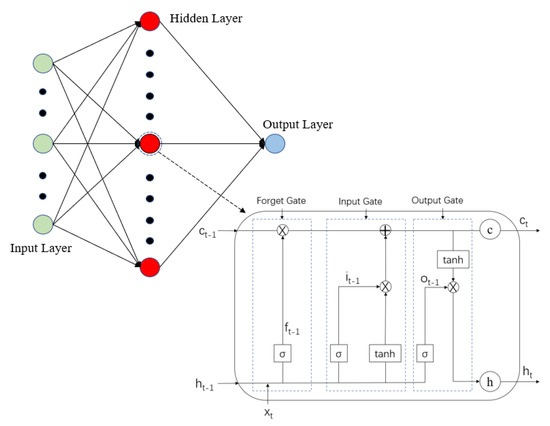
Figure 1.
LSTM model structure diagram.
2.3. Long Short-Term Memory Fully Connected Model
To improve the prediction performance of the model, a fully connected layer is added to the model after the hidden layer of the LSTM. The periodic displacement of the Baishuihe landslide and Bazimen landslide is mainly influenced by rainfall and reservoir water levels, which are periodic and repetitive. Therefore, the function of adding a fully connected layer is to receive information from each node of the LSTM and synthesize the characteristic information of each node in the LSTM. Therefore, each node in the fully connected layer will not ignore the rainfall and reservoir water level information before and after predicting the final result. Then, a correction linear unit (ReLU) activation function is used to avoid the effect of the neural network vanishing gradient [44,45]. Finally, the model uses an output unit to calculate predicted landslide displacement data. At present, a lot of applications use the LSTM-FC model, including biomedical engineering [45], photovoltaic power generation forecasting [46], PM2.5 concentration prediction [47], medical treatment [44], and human action recognition [48]. The structure of the LSTM model after adding a fully connected layer is shown as Figure 2:
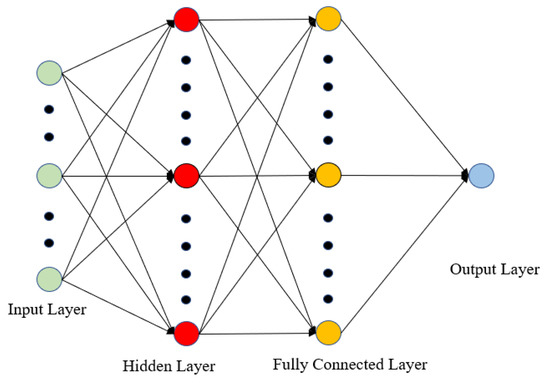
Figure 2.
LSTM-FC model structure diagram.
2.4. Landslide Displacement Prediction Process
Figure 3 expresses the whole specific process of landslide prediction, which is as follows.
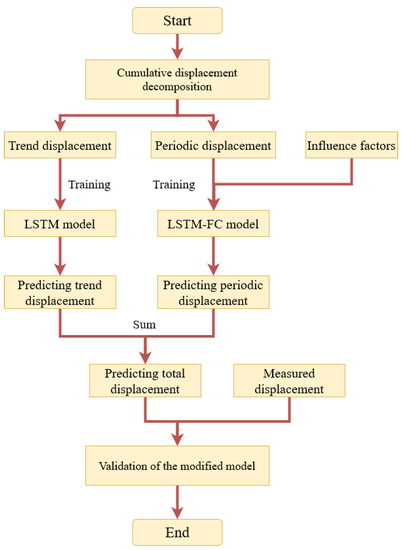
Figure 3.
Flowchart of the prediction process.
Step 1: Because landslides are always affected by their own geological attributes and external factors over time, many studies regard landslide displacement as time series data analysis. However, the previous studies ignored the time series data in the analysis. For the current situation, data at different times should have different weights. Therefore, considering that the data closer to the present is more valuable, this paper proposes the WMA method to decompose the historical cumulative displacement and obtain the displacement trend and periodic displacement of the cumulative displacement.
Step 2: The trend displacement of landslide is mainly affected by landslide itself, so we consider the trend displacement data has time series property. Previous research treated trend displacement as general information data. This will ignore the development rule of time series data. Therefore, this paper would use the trend displacement to train the LSTM model, and then predict the trend displacement.
Step 3: The periodic displacement is primarily impacted by environmental influences and the variation of periodic term is not as stable as trend displacement. Baishuihe landslide and Bazimen landslide are both located in the Yangtze River basin and they are mainly affected by rainfall and reservoir water level. The periodic displacement changes with seasonal rainfall and the changes in reservoir water level each year. Because periodic term has similar changes in each period, we need to make full use of all similar changes information during training and predicting. Therefore, a fully connected layer is connected after the LSTM model in this paper, so that every node has information within all periods. Then, the LSTM-FC model predicts periodic displacement.
Step 4: On the basis of Formula 1, the predicted landslide displacement can be predicted by summing the trend displacement obtained in Step 2 to the periodic displacement obtained in Step 3.
Step 5: After the above steps, the final landslide predicted displacement is obtained. In order to check the prediction performance of the modified model, we applied the model to two actual landslides, and the predicted cumulative displacement was compared with other prediction models and measured displacement. The final comparison results verified the accuracy of the proposed model.
3. Results
In this research, the practical performance of the modified model for landslide displacement prediction is verified by using the Baishuihe and Bazimen landslides. The specific geographical locations of two landslides are shown in Figure 4.
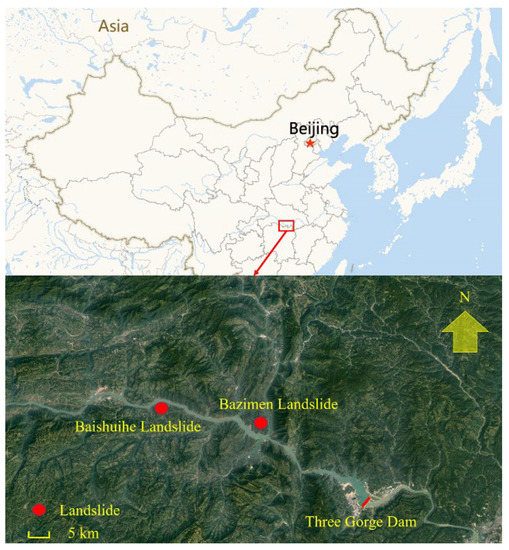
Figure 4.
Geographical locations of the Baishuihe and Bazimen landslides.
3.1. Baishuihe Landslide
The Baishuihe landslide is located in Baishuihe village, Shazhenxi town, 56 km from the site of the Three Gorges Dam. The geographical coordinates are 110°32′09″ longitude and 31°01′34″ latitude. The slope is low in the north and high in the south. The elevation of the trailing edge is 410 m, with the leading edge reaching the Yangtze River and bounded by a bedrock ridge on the east and west sides, with an overall slope of approximately 30°. The volume of Baishuihe landslide is 1260 × 104 m3, and the average thickness is about 30 m. The length from south to north is 600 m and the length from east to west is 700 m. It is an accumulation landslide, and the slope body is a straight slope.
Based on the topography, geological conditions, deformation characteristics and observation requirement of Baishuihe landslide, it is determined that the main monitoring contents of the landslide are surface displacement monitoring, borehole inclination monitoring and underground water level monitoring. At the beginning of monitoring, there were seven GPS devices distributed on three longitudinal sections, with three GPS monitoring points on the middle section and two on both sides. After that, four GPS monitoring points were successively established in the landslide warning area. The ZG118 station is installed at the center of the landslide, which can reflect the entire variation in landslide development, and the data of ZG118 is complete and the time is relatively long, which is suitable for experimental simulation modeling. Therefore, this study uses the ZG118 data to simulate the displacement of the Baishuihe landslide. The topographic map of the Baishuihe landslide is shown in Figure 5.
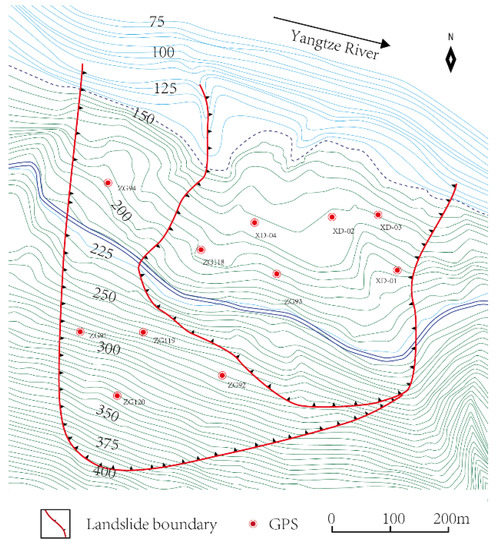
Figure 5.
The topographic map of the Baishuihe landslide.
This study uses 100 groups of data of Baishuihe landslide. Each group contains landslide displacement, rainfall and reservoir level data. The data begin in September 2004 and end in December 2012, and its collection frequency is once a month. This data set can be acquired for academic research by the National Cryosphere Desert Data Center/National Service Center for Speciality Environmental Observation Stations. These data are shown in Figure 6. The capacity and availability of the modified model we designed can be verified by modeling and simulation of these data.
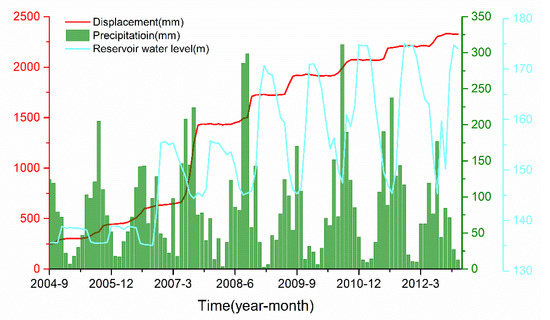
Figure 6.
Relationship between the displacement of Baishuihe landslide and external environmental factors.
The cumulative displacement of the Baishuihe landslide is decomposed by the WMA method, and then the actual displacement trend and the detached periodic displacement can be worked out. The curves of cumulative displacement, displacement trend and periodic displacement are shown in Figure 7.

Figure 7.
Decomposition results of the displacements measured at station ZG118.
3.2. Bazimen Landslide
The Bazimen landslide is located on the right bank of the Xiangxi River, a tributary of the north bank of the Yangtze River, in Guizhou town of Zigui County, Hubei Province, 31 km from the Three Gorges Dam. The Xiangxi River is north–south, almost crossing the Yangtze River, and the Three Gorges Reservoir submerged landslide front has 55 m to 135 m elevation sections.
The landslide is located on the right bank of the Xiangxi River, and the slope is north–south. The landslide is an accumulation layer landslide and is arranged in the shape of a dustpan at the foot of the bank slope. The geographical coordinates are longitude 110°45′30″ and latitude 30°58′16″.
The elevation of the landslide is 139 m to 280 m, high in the west and low in the east, with an inclination to the east. The slope of the landslide surface is 10° to 30°, showing step undulation. There are still two platforms: the leading-edge platform and the back edge platform, with elevations of 139 m to 165 m and 220 m to 230 m, respectively. The back wall of the landslide is a steep slope with a slope foot of approximately 40° to 60°, and the front face is the Xiangxi River. The length of the landslide is 350 m, the width is 350 m to 500 m, the average thickness is 30 m, and the volume is approximately 4 million m3.
There are three GPS deformation monitoring points (ZG111, ZG110, ZG112) within the landslide area. In this research, the ZG111 location is selected as the monitoring point for the Bazimen landslide because it has the longest available monitoring data series and the largest landslide deformation. The topographic map of the Baishuihe landslide is shown in Figure 8.
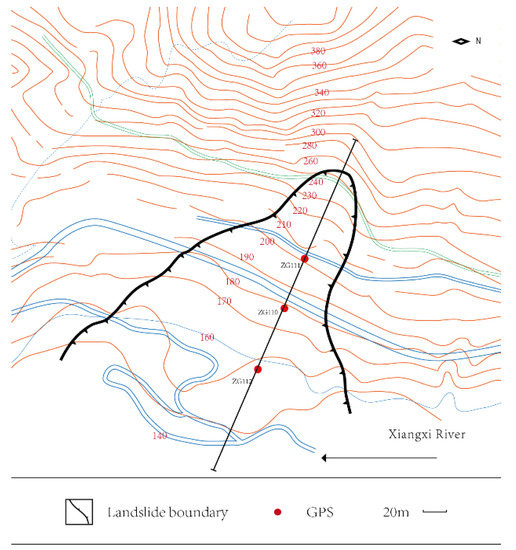
Figure 8.
The topographic map of the Bazimen landslide.
This study uses 60 groups of data of Bazimen landslide. Each group contains landslide displacement, rainfall and reservoir level data. The data begin in January 2008 and end in December 2012, and its collection frequency is once a month. This data set can be acquired for academic research by the National Cryosphere Desert Data Center/National Service Center for Speciality Environmental Observation Stations. The data are collected once a month and shown in Figure 9. The capacity and availability of the modified model we designed can be verified by modeling and simulating these data.
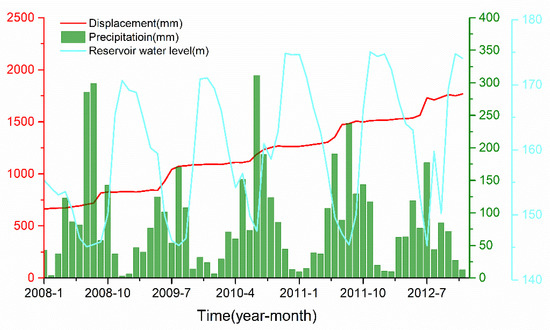
Figure 9.
Relationship between the displacement of Bazimen landslide and external environmental factors.
The cumulative displacement of the Bazimen landslide is decomposed by the WMA method, and then the actual displacement trend and actual periodic displacement are obtained. The curves of cumulative displacement, displacement trend and periodic displacement are shown in Figure 10.
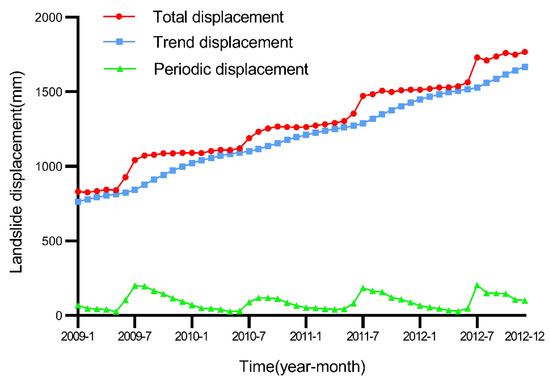
Figure 10.
Decomposition results of the displacements measured at station ZG111.
After time series analysis and decomposition by WMA method, trend displacement and periodic displacement are obtained. As can be seen from Figure 7 and Figure 10, the trend displacement is a steady and gradually rising curve that changes slowly over time. The trend displacement is due to the slow generation of landslide structure under the action of gravity, and will not change with the change in external factors. Periodic displacement is different from trend displacement. The periodic displacement changes periodically. When the rainfall is very little or the reservoir water level is high, the periodic displacement is close to 0, and when the rainfall is large or the reservoir water level drops rapidly, the periodic displacement rises fastest. This shows that the change in periodic displacement is accompanied by the change in external factors, and the more severe the change in external factors, the faster the rise of periodic displacement. After time series analysis of landslide displacement and decomposition by WMA method, we can predict trend displacement and periodic displacement, respectively.
3.3. Trend Displacement Prediction
Because the displacement trend represents the intrinsic displacement change inside a landslide, it is less affected by external influences. In addition, the displacement trend of a landslide can represent the current state of the landslide, so this study uses the displacement trend of the first 12 months of a landslide to indirectly represent the state of landslide as the input variable to the LSTM model to predict the trend term of displacement and the predicted trend displacement as the output sequence. In this paper, the displacement trend data of the Baishuihe landslide in the first 76 months and of the Bazimen landslide in the first 48 months are used as the training data of the model to predict the trend displacements of Baishuihe landslide after 24 months and of Bazimen landslide after 12 months. The comparison between the prediction and actual results is shown in Figure 11 and Figure 12. It is obvious the modified model can precisely fit and predict the trend displacement of both landslides.
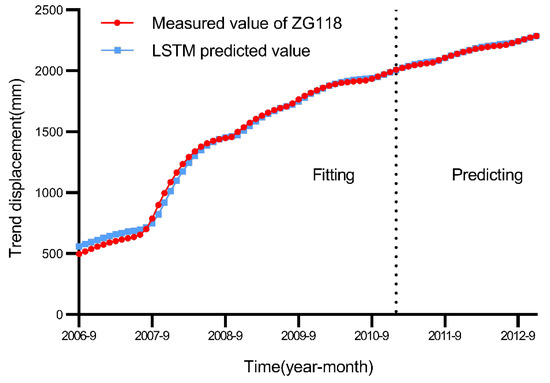
Figure 11.
Fitting and predicting results of trend displacement of ZG118.
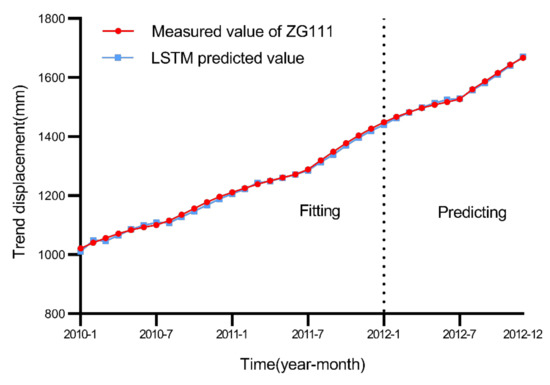
Figure 12.
Fitting and predicting results of trend displacement of ZG1113.4. Periodic displacement prediction.
It can be seen from Figure 6 and Figure 9 that the cumulative displacement of the Baishuihe and Bazimen landslides began to increase rapidly in the first few months of the rainy season and when the reservoir water level decreased. After the rainy season and when the reservoir water level was stable, the change in landslide displacement basically ended. It can be concluded that the changes in rainfall and reservoir water level have a profound influence on the changes in the displacement of the Baishuihe and Bazimen landslides and are the inducing factors of the changes in the displacement of the two landslides. Therefore, the rainfall and reservoir water level are used as input variables to the LSTM-FC model to predict periodic landslide displacement, and the predicted periodic displacement is the output sequence. The periodic displacement data of Baishuihe landslide in the first 76 months and of Bazimen landslide in the first 48 months are used as the training data of the model to predict the periodic displacements of the Baishuihe landslide after 24 months and of the Bazimen landslide after 12 months. The comparison between the prediction and actual results is shown in Figure 13 and Figure 14. The modified model we proposed can precisely predict the periodic displacement of both landslides.
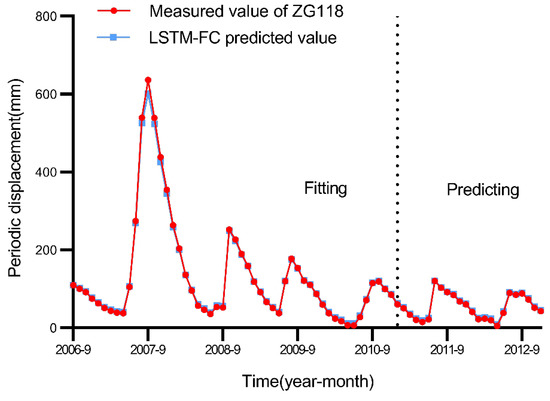
Figure 13.
Fitting and predicting results of periodic displacement of ZG118.
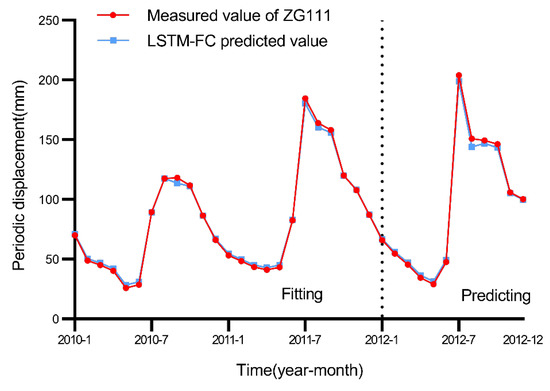
Figure 14.
Fitting and predicting results of periodic displacement of ZG111.
3.4. Total Displacement Prediction
After calculating the predicted displacement trend and periodic displacement, according to the displacement time series data decomposition principle (Equation (1)), the trend and periodic displacement of corresponding time are directly added to acquire the final predicted displacement of two landslides. The predicted final landslide displacements are shown in Figure 15 and Figure 16.
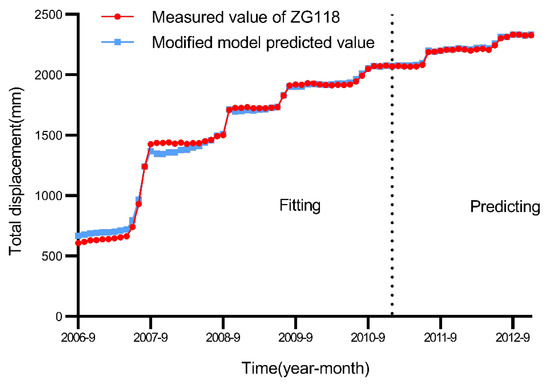
Figure 15.
Fitting and predicting results of cumulative displacement of ZG118.
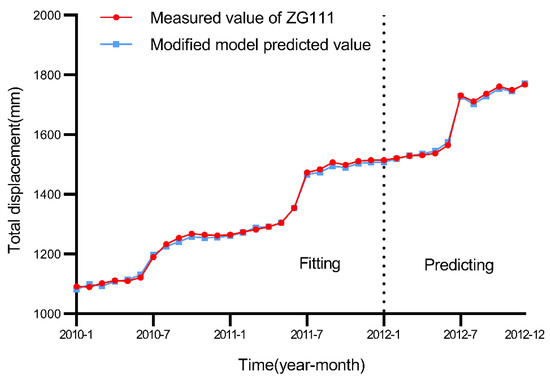
Figure 16.
Fitting and predicting results of cumulative displacement of ZG111.
As shown in Figure 15 and Figure 16, when the amount of data is small, the performance of the model training for actual cumulative displacement is not very good, and there are certain fluctuations around the actual displacement data. However, as the amount of training data increases, the fitting performance of the model after training also improves. The total displacement predicted by using the training set is in good agreement with the actual total displacement. In general, the proposed model in this paper can accurately predict the total displacement of both landslides.
4. Discussion
To accurately estimate the prediction capacity of the model, performance indexes were used to evaluate the performance and accuracy [49,50,51,52]. This study uses three evaluation indicators: the Root Mean Square Error (RMSE), the Mean Absolute Error (MAE) and Mean Absolute Percentage Error (MAPE). The MAE is a basic evaluation index, reflecting the overall gap between the predicted value and actual data. The RMSE is sensitive to outliers. If a prediction point is unreasonable, the RMSE value will be greatly affected. The MAPE evaluation index not only considers the error between the predicted value and true value but also considers the relationship between the error and true value. The three evaluation indexes are calculated as follows:
where denotes the number of data points, denotes the average measured values; denotes the predicted value, and denotes the measured value. The smaller the value of the three evaluation indexes, the better the performance and accuracy of the model.
To demonstrate the superiority of the proposed algorithm over traditional methods, we compare the prediction performance of the displacement trend and periodic displacement with other algorithms. After comparison, each algorithm is evaluated and further discussed by using the evaluation index to evaluate the prediction performance. We first compare the displacement trends of the two landslides. Since the displacement trend of a landslide is mainly affected by the geological conditions of the landslide itself rather than external factors, the model discussed in this paper is used to directly predict the displacement trend, and the results are compared with a polynomial model [29,30,31,32]. The experimental simulation results of the two algorithms are compared with the actual displacement trend, and the calculated comparison results are shown in Figure 17 and Figure 18.
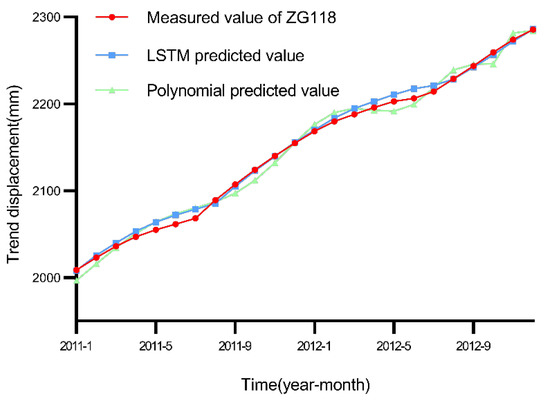
Figure 17.
Trend displacement predicted results of ZG118.
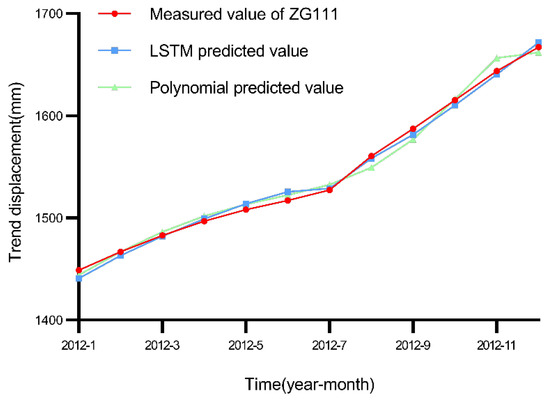
Figure 18.
Trend displacement predicted results of ZG111.
After several experiments and simulations, the construction of the LSTM model is set as follows. Considering that each year is a prediction cycle, the time step is set to 12, the learning rate is set to 0.01, and the amount of hidden layer nodes is set to 50. In this paper, the polynomial parameters in [29,30,31,32] are adopted, and the power of the polynomial is set to 3. Figure 17 and Figure 18 show that the prediction results of the LSTM model discussed in this paper are closer to the actual displacement trend. Table 1 reports the predictive performance of the two algorithms.

Table 1.
Evaluation index results of each model for trend displacement prediction.
It can be seen from Table 1 that the LSTM model is more excellent than the Polynomial model in predicting trend displacement. The prediction result of Baishuihe landslide is better than Bazimen landslide. We believe that because the LSTM model is an artificial intelligence algorithm. As there are more data in Baishuihe landslide, the LSTM model gets more training opportunities, so the prediction performance will improve with the increase in data.
After the simulation verification of the displacement trend of the two landslides, the next step is to verify the periodic displacement performance of the two landslides predicted by the LSTM-FC model. Because the periodic displacements of the Baishuihe and Bazimen landslides are more affected by rainfall and reservoir water level, the influence is periodic and repetitive, so this study adds a fully connected layer after the LSTM so that each node in the fully connected layer can completely receive periodic displacement information at all time points. The comparison of the periodic displacements is shown in Figure 19, Figure 20, Figure 21, Figure 22, Figure 23, Figure 24, Figure 25 and Figure 26.
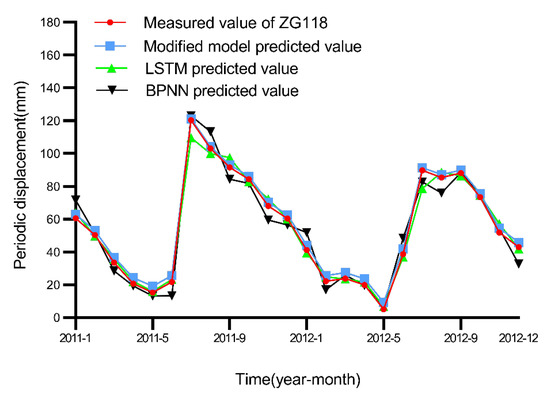
Figure 19.
Periodic displacement predicted results of ZG118 using LSTM-FC, LSTM and BPNN models.
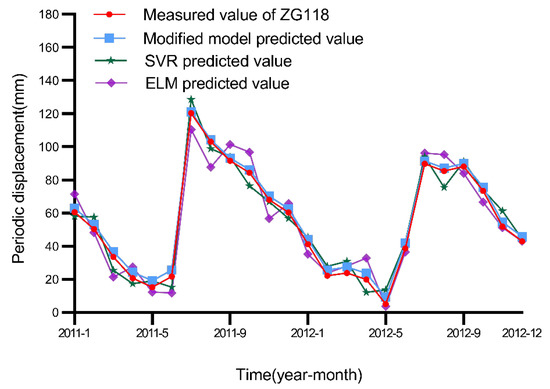
Figure 20.
Periodic displacement predicted results of ZG118 using LSTM-FC, SVR and ELM models.
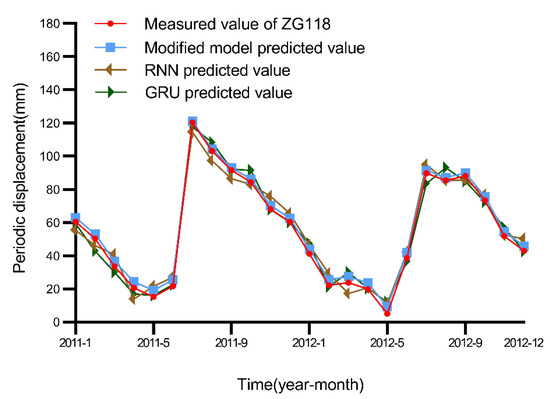
Figure 21.
Periodic displacement predicted results of ZG118 using LSTM-FC, RNN and GRU models.
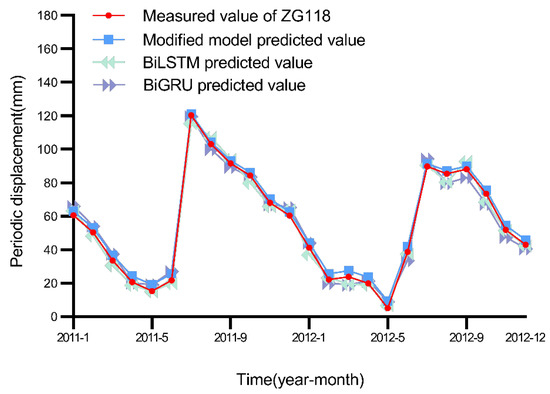
Figure 22.
Periodic displacement predicted results of ZG118 using LSTM-FC, BiLSTM and BiGRU models.
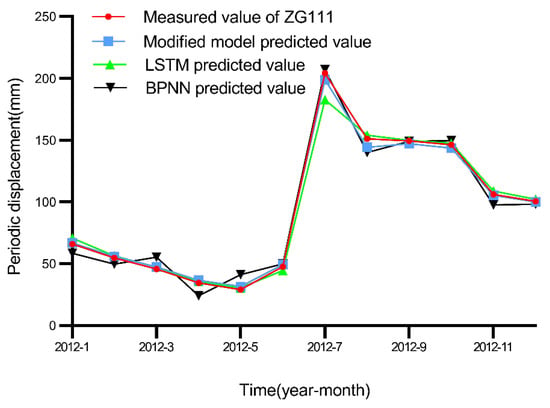
Figure 23.
Periodic displacement predicted results of ZG111 using LSTM-FC, LSTM and BPNN models.

Figure 24.
Periodic displacement predicted results of ZG111 using LSTM-FC, SVR and ELM models.
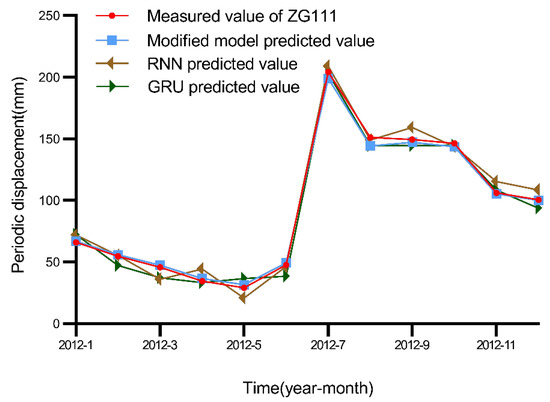
Figure 25.
Periodic displacement predicted results of ZG111 using LSTM-FC, RNN and GRU models.
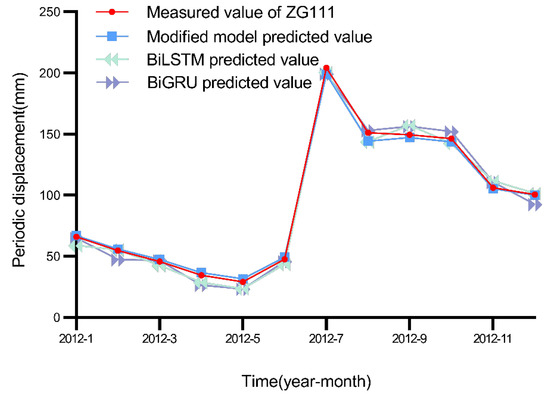
Figure 26.
Periodic displacement predicted results of ZG111 using LSTM-FC, BiLSTM and BiGRU models.
We set the time step of the LSTM-FC model to 12, the learning rate is 0.01, and the amount of hidden layer nodes is 50. For LSTM, BPNN, ELM, RNN, GRU, BiLSTM and BiGRU models, the parameter settings are the same as the LSTM-FC model. For the SVR model, the gamma parameter is 0.01 and the kernel parameter is ‘rbf’. We compare the LSTM-FC model with eight other models, the LSTM, BPNN, SVR, ELM, RNN, GRU, BiLSTM and BiGRU models, to prove its excellent predictive performance. All algorithms are used to predict the periodic displacement of the two landslides independently but are not combined with the displacement trend prediction algorithm.
Figure 19, Figure 20, Figure 21, Figure 22, Figure 23, Figure 24, Figure 25 and Figure 26 also show that the simulation results of the LSTM-FC model in this paper are closer to the measured periodic displacement. Table 2 reports the predictive performance of the five algorithms.

Table 2.
Evaluation index results of each model for periodic displacement prediction.
The evaluation index data in the table show that the LSTM-FC model has obvious advantages over the other algorithms in terms of prediction ability, whether from the perspective of overall prediction or from the perspective of error between individual predicted and actual data. Table 2 shows that compared with other eight models, the LSTM-FC and other time series models are more suitable for processing time series data such as cyclic landslide displacement. However, the LSTM-FC model considers the repeatability and periodicity of changes in the rainfall and reservoir water level in every cycle. After adding the fully connected layer, the model considers changes in external environmental factors before and after the cycle during training, which improves the prediction ability of the model.
It can be seen from the results that the prediction effect of time series models is generally better than the general machine learning models, and the prediction effect of Baishuihe landslide is better than Bazimen landslide. It should be that the deep learning model is more suitable for the case of large amount of data, especially the BiLSTM model. We believe that this may be because BiLSTM is also a model that considers periodic changes in data, and takes the repetition and periodicity of external environmental factors changes in each cycle into account in the training process, so its prediction performance is also excellent. Although the modified model has achieved excellent performance in landslide displacement prediction, it still has two shortcomings. As an improved and more com-plex deep learning method, the model proposed in this paper has more parameters than a traditional LSTM model, which makes it more difficult to tune the model parameters and obtain the optimal solution of all parameters. The second disadvantage is that the model proposed in this paper has certain requirements on the quantity and size of the data sets. When the number of training sets is small, the modified model cannot fully train the parameters to reach the optimal value, which affects the prediction performance of the model and leads to some errors. In the future, this model will be used as a part of landslide warning system to improve the warning performance of landslide warning system. We will also adjust the structure and parameters of the modified model for different landslides, so that the model can better adapt to different landslides. We will continue to improve the prediction model by using the data augmentation method to achieve better prediction performance in the case of a small amount of data.
5. Conclusions
Landslides are serious and complex geological and natural disasters that threaten the safety of people’s lives and property worldwide. To face this challenge, a landslide displacement prediction model based on time series analysis and modified LSTM model is proposed in this paper. Considering that data from different time periods have different time values, the WMA method is adopted to decompose the cumulative landslide displacement into the displacement trend and periodic displacement. To predict the displacement trend, we combined the displacement trend of landslides in the early stage with an LSTM model. Considering the repeatability and periodicity of external environmental factors in every cycle, the LSTM-FC model was constructed by adding a fully connected layer to the traditional LSTM model. Then, the modified model directly predicted periodic displacement. The two predicted displacements were added to acquire the landslide predicted displacement. In this paper, under the same conditions, we used a polynomial function algorithm to compare and predict the displacement trend with the LSTM model and used the LSTM-FC model to compare and predict the displacement trend with eight other commonly used algorithms. The prediction results indicate that the proposed prediction model is able to effectively predict landslide displacement.
Author Contributions
Funding acquisition, Y.J. and X.S.; writing—review and editing, X.S. and Z.L.; conceptualization, X.S. and Z.L.; writing—review and editing, X.S. and Z.L.; writing—original draft preparation, X.S. and Z.L.; resources, Y.J. and Z.L. All authors have read and agreed to the published version of the manuscript.
Funding
This research was funded by the Natural Science Foundation of Guangxi Province of China under Grant 2019GXNSFBA245072 and Grant 2018GXNSFAA294054, Department of Science and Technology of Guangxi Zhuang Autonomous Region under Grand AB21196041, Grand AA19254029, Grand AA19182007 and Grand AA20302022, and the National Natural Science Foundation of China under Grand 62161007, Grand 62061010 and Grand 61861008.
Institutional Review Board Statement
Not applicable.
Informed Consent Statement
Not applicable.
Data Availability Statement
Restrictions apply to the availability of these data. Data were obtained from the National Cryosphere Desert Data Center/National Service Center for Speciality Environmental Observation Stations and are available from http://data.casnw.net/portal/ (accessed on 19 January 2021) with the permission of the National Cryosphere Desert Data Center/National Service Center for Speciality Environmental Observation Stations.
Acknowledgments
All authors would like to acknowledge the National Cryosphere Desert Data Center/National Service Center for Speciality Environmental Observation Stations for providing data and material.
Conflicts of Interest
The authors declare no conflict of interest.
References
- Tordesillas, A.; Zhou, Z.; Batterham, R. A data-driven complex systems approach to early prediction of landslides. Mech. Res. Commun. 2018, 92, 137–141. [Google Scholar] [CrossRef]
- Ju, N.; Huang, J.; He, C.; Van Asch, T.W.; Huang, R.; Fan, X.; Xu, Q.; Xiao, Y.; Wang, J. Landslide early warning, case studies from Southwest China. Eng. Geol. 2020, 279, 105917. [Google Scholar] [CrossRef]
- Gumiran, B.A.; Daag, A. Negotiated participatory action research for multi-stakeholder implementation of early warning systems for landslides. Int. J. Disaster Risk Reduct. 2021, 58, 102184. [Google Scholar] [CrossRef]
- Gamperl, M.; Singer, J.; Thuro, K. Internet of Things Geosensor Network for Cost-Effective Landslide Early Warning Systems. Sensors 2021, 21, 2609. [Google Scholar] [CrossRef] [PubMed]
- Niu, H. Smart safety early warning model of landslide geological hazard based on BP neural network. Saf. Sci. 2020, 123, 104572. [Google Scholar]
- Liu, Z.; Xu, W.Y.; Shao, J.F. Gauss Process Based Approach for Application on Landslide Displacement Analysis and Prediction. Comput. Modeling Eng. Sci. 2012, 84, 99–122. [Google Scholar]
- Li, S.H.; Wu, L.Z.; Chen, J.J.; Huang, R.Q. Multiple data-driven approach for predicting landslide deformation. Landslide 2020, 17, 709–718. [Google Scholar] [CrossRef]
- Liu, Y.; Xu, C.; Huang, B.; Ren, X.; Liu, C.; Hu, B.; Chen, Z. Landslide displacement prediction based on multi-source data fusion and sensitivity states. Eng. Geol. 2020, 271, 105608. [Google Scholar] [CrossRef]
- Wang, Y.; Tang, H.; Wen, T.; Ma, J. A hybrid intelligent approach for constructing landslide displacement prediction intervals. Appl. Soft Comput. 2019, 81, 105506. [Google Scholar] [CrossRef]
- Jiang, Y.; Luo, H.; Xu, Q.; Lu, Z.; Liao, L.; Li, H.; Hao, L. A Graph Convolutional Incorporating GRU Network for Landslide Displacement Forecasting Based on Spatiotemporal Analysis of GNSS Observations. Remote Sens. 2022, 14, 1016. [Google Scholar] [CrossRef]
- Long, J.; Li, C.; Liu, Y.; Feng, P.; Zuo, Q. A multi-feature fusion transfer learning method for displacement prediction of rainfall reservoir-induced landslide with step-like deformation characteristics. Eng. Geol. 2022, 297, 106494. [Google Scholar] [CrossRef]
- Krkač, M.; Gazibara, S.B.; Arbanas, Ž.; Sečanj, M.; Arbanas, S.M. A comparative study of random forests and multiple linear regression in the prediction of landslide velocity. Landslide 2020, 17, 2515–2531. [Google Scholar] [CrossRef]
- Li, X.; Li, S. Large-Scale Landslide Displacement Rate Prediction Based on Multi-Factor Support Vector Regression Machine. Appl. Sci. 2021, 11, 1381. [Google Scholar] [CrossRef]
- Liu, Q.; Jian, W.; Nie, W. Rainstorm-induced landslides early warning system in mountainous cities based on groundwater level change fast prediction. Sustain. Cities Soc. 2021, 69, 102817. [Google Scholar] [CrossRef]
- Abraham, M.T.; Satyam, N.; Rosi, A.; Pradhan, B.; Segoni, S. Usage of antecedent soil moisture for improving the performance of rainfall thresholds for landslide early warning. Catena 2021, 200, 105147. [Google Scholar] [CrossRef]
- Abraham, M.T.; Satyam, N.; Bulzinetti, M.A.; Pradhan, B.; Pham, B.T.; Segoni, S. Using Field-Based Monitoring to Enhance the Performance of Rainfall Thresholds for Landslide Warning. Water 2020, 12, 3453. [Google Scholar] [CrossRef]
- Xing, Y.; Yue, J.; Chen, C.; Qin, Y.; Hu, J. A hybrid prediction model of landslide displacement with risk-averse adaptation. Comput. Geosci. 2020, 141, 104527. [Google Scholar] [CrossRef]
- Lian, C.; Zeng, Z.; Wang, X.; Yao, W.; Su, Y.; Tang, H. Landslide displacement interval prediction using lower upper bound estimation method with pre-trained random vector functional link network initialization. Neural Netw. 2020, 130, 286–296. [Google Scholar] [CrossRef]
- Du, H.; Song, D.; Chen, Z.; Shu, H.; Guo, Z. Prediction model oriented for landslide displacement with step-like curve by applying ensemble empirical mode decomposition and the PSO-ELM method. J. Clean. Prod. 2020, 270, 122248. [Google Scholar] [CrossRef]
- Wang, J.; Nie, G.; Gao, S.; Wu, S.; Li, H.; Ren, X. Landslide Deformation Prediction Based on a GNSS Time Series Analysis and Recurrent Neural Network Model. Remote Sens. 2021, 13, 1055. [Google Scholar] [CrossRef]
- Zhou, C.; Yin, K.; Cao, Y.; Intrieri, E.; Ahmed, B.; Catani, F. Displacement prediction of step-like landslide by applying a novel kernel extreme learning machine method. Landslides 2018, 15, 2211–2225. [Google Scholar] [CrossRef] [Green Version]
- Liu, Z.Q.; Guo, D.; Lacasse, S.; Li, J.H.; Yang, B.B.; Choi, J.C. Algorithms for intelligent prediction of landslide displacements. J. Zhejiang Univ. Sci. A 2020, 21, 412–429. [Google Scholar] [CrossRef]
- Xing, Y.; Yue, J.; Chen, C.; Cong, K.; Zhu, S.; Bian, Y. Dynamic Displacement Forecasting of Dashuitian Landslide in China Using Variational Mode Decomposition and Stack Long Short-Term Memory Network. Appl. Sci. 2019, 9, 2951. [Google Scholar] [CrossRef] [Green Version]
- Wu, L.Z.; Li, S.H.; Huang, R.Q.; Xu, Q. A new grey prediction model and its application to predicting landslide displacement. Appl. Soft Comput. J. 2020, 45, 5347–5361. [Google Scholar] [CrossRef]
- Guo, Z.; Chen, L.; Gui, L.; Du, J.; Yin, K.; Do, H.M. Landslide displacement prediction based on variational mode decomposition and WA-GWO-BP model. Landslide 2020, 17, 567–583. [Google Scholar] [CrossRef]
- Han, H.; Shi, B.; Zhang, L. Prediction of landslide sharp increase displacement by SVM with considering hysteresis of groundwater change. Eng. Geol. 2021, 280, 105876. [Google Scholar] [CrossRef]
- Deng, L.; Smith, A.; Dixon, N.; Yuan, H. Machine learning prediction of landslide deformation behaviour using acoustic emission and rainfall measurements. Eng. Geol. 2021, 293, 106315. [Google Scholar] [CrossRef]
- Wang, C.; Zhao, Y.; Bai, L.; Guo, W.; Meng, Q. Landslide Displacement Prediction Method Based on GA-Elman Model. Appl. Sci. 2021, 11, 11030. [Google Scholar] [CrossRef]
- Zhou, C.; Yin, K.; Cao, Y.; Ahmed, B. Application of time series analysis and PSO–SVM model in predicting the Bazimen landslide in the Three Gorges Reservoir, China. Eng. Geol. 2016, 204, 108–120. [Google Scholar] [CrossRef]
- Miao, F.; Wu, Y.; Xie, Y.; Li, Y. Prediction of landslide displacement with step-like behavior based on multialgorithm optimization and a support vector regression model. Landslide 2017, 15, 475–488. [Google Scholar] [CrossRef]
- Wang, R.; Zhang, K.; Wang, W.; Meng, Y.; Yang, L.; Huang, H. Hydrodynamic landslide displacement prediction using combined extreme learning machine and random search support vector regression model. Eur. J. Environ. Civ. Eng. 2020, 2020, 1–13. [Google Scholar] [CrossRef]
- Yang, B.; Yin, K.; Lacasse, S.; Liu, Z. Time series analysis and long short-term memory neural network to predict landslide displacement. Landslides 2019, 16, 677–694. [Google Scholar] [CrossRef]
- Liu, Q.; Lu, G.; Dong, J. Prediction of landslide displacement with step-like curve using variational mode decomposition and periodic neural network. Bull. Eng. Geol. Environ. 2021, 80, 3783–3799. [Google Scholar] [CrossRef]
- Zhang, Y.G.; Tang, J.; He, Z.Y.; Tan, J.; Li, C. A novel displacement prediction method using gated recurrent unit model with time series analysis in the Erdaohe landslide. Nat. Hazards 2021, 105, 783–813. [Google Scholar] [CrossRef]
- Hu, X.; Wu, S.; Zhang, G.; Zheng, W.; Liu, C.; He, C.; Liu, Z.; Guo, X.; Zhang, H. Landslide displacement prediction using kinematics-based random forests method: A case study in Jinping Reservoir Area, China. Eng. Geol. 2021, 283, 105975. [Google Scholar] [CrossRef]
- Xie, P.; Zhou, A.; Chai, B. The Application of Long Short-Term Memory(LSTM) Method on Displacement Prediction of Multifactor-Induced Landslides. IEEE Access 2019, 7, 54305–54311. [Google Scholar] [CrossRef]
- Ma, J.; Tang, H.; Liu, X.; Hu, X.; Sun, M.; Song, Y. Establishment of a deformation forecasting model for a step-like landslide based on decision tree C5.0 and two-step cluster algorithms: A case study in the Three Gorges Reservoir area, China. Landslide 2017, 14, 1275–1281. [Google Scholar] [CrossRef]
- Lin, Z.; Sun, X.; Ji, Y. Landslide Displacement Prediction based on Time Series Analysis and Double-BiLSTM Model. Int. J. Environ. Res. Public Health 2022, 19, 2077. [Google Scholar] [CrossRef]
- Lian, C.; Zhu, L.; Zeng, Z.; Su, Y.; Yao, W.; Tang, H. Constructing prediction intervals for landslide displacement using bootstrapping random vector functional link networks selective ensemble with neural networks switched. Neurocomputing 2018, 291, 1–10. [Google Scholar] [CrossRef]
- Chikalamo, E.E.; Mavrouli, O.C.; Ettema, J.; van Westen, C.J.; Muntohar, A.S.; Mustofa, A. Satellite-derived rainfall thresholds for landslide early warning in Bogowonto Catchment, Central Java, Indonesia. Int. J. Appl. Earth Obs. Geoinf. 2020, 89, 102093. [Google Scholar] [CrossRef]
- Wang, Y.; Tang, H.; Huang, J.; Wen, T.; Ma, J.; Zhang, J. A comparative study of different machine learning methods for reservoir landslide displacement prediction. Eng. Geol. 2022, 298, 106544. [Google Scholar] [CrossRef]
- Zhang, J.; Tang, H.; Tannant, D.D.; Lin, C.; Xia, D.; Liu, X.; Zhang, Y.; Ma, J. Combined forecasting model with CEEMD-LCSS reconstruction and the ABC-SVR method for landslide displacement prediction. J. Clean. Prod. 2021, 293, 126205. [Google Scholar] [CrossRef]
- Hochreiter, S.; Schmidhuber, J. Long short-term memory. Neural Comput. 1997, 9, 1735–1780. [Google Scholar] [CrossRef]
- Rafiei, A.; Rezaee, A.; Hajati, F.; Gheisari, S.; Golzan, M. SSP: Early Prediction of Sepsis using Fully Connected LSTM-CNN Model. Comput. Biol. Med. 2020, 128, 104110. [Google Scholar] [CrossRef] [PubMed]
- Wang, H.; Shi, H.; Lin, K.; Qin, C.; Zhao, L.; Huang, Y.; Liu, C. A high-precision arrhythmia classification method based on dual fully connected neural network. Biomed. Signal Process. Control 2020, 58, 101874. [Google Scholar] [CrossRef]
- Li, Y.; Ye, F.; Liu, Z.; Wang, Z.; Mao, Y. A Short-Term Photovoltaic Power Generation Forecast Method Based on LSTM. Math. Probl. Eng. 2021, 2021, 6613123. [Google Scholar] [CrossRef]
- Zhao, J.; Deng, F.; Cai, Y.; Chen, J. Long Short-Term Memory-Fully Connected (LSTM-FC) Neural Network for PM2.5 Concentration Prediction. Chemosphere 2019, 220, 486–492. [Google Scholar] [CrossRef]
- Zhang, Z.; Lv, Z.; Gan, C.; Zhu, Q. Human action recognition using convolutional LSTM and fully-connected LSTM with different attentions. Neurocomputing 2020, 410, 304–316. [Google Scholar] [CrossRef]
- Manzo, M.; Pellino, S. Voting in transfer learning system for ground-based cloud classification. Mach. Learn. Knowl. Extr. 2021, 3, 542–553. [Google Scholar] [CrossRef]
- Lu, H.; Ma, X.; Ma, M. A hybrid multi-objective optimizer-based model for daily electricity demand prediction considering COVID-19. Energy 2021, 219, 119568. [Google Scholar] [CrossRef]
- Xu, S.; Niu, R. Displacement prediction of Baijiabao landslide based on empirical mode decomposition and long short-term memory neural network in Three Gorges area, China. Comput. Geosci. 2018, 111, 87–96. [Google Scholar] [CrossRef]
- Ma, J.; Tang, H.; Liu, X.; Wen, T.; Zhang, J.; Tan, Q.; Fan, Z. Probabilistic forecasting of landslide displacement accounting for epistemic uncertainty: A case study in the Three Gorges Reservoir area, China. Landslides 2018, 15, 1145–1153. [Google Scholar] [CrossRef]
Publisher’s Note: MDPI stays neutral with regard to jurisdictional claims in published maps and institutional affiliations. |
© 2022 by the authors. Licensee MDPI, Basel, Switzerland. This article is an open access article distributed under the terms and conditions of the Creative Commons Attribution (CC BY) license (https://creativecommons.org/licenses/by/4.0/).